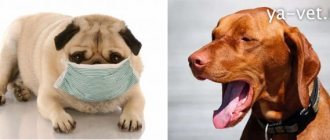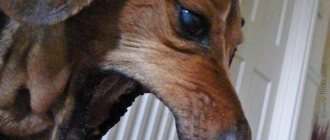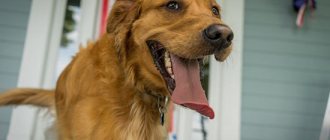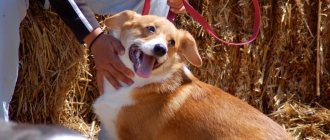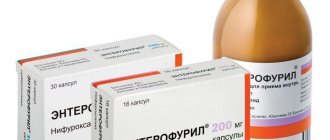Why does a dog cough?
The causes of cough in dogs can be very diverse. Conventionally, they can be divided into two groups: those associated with diseases of internal organs and household ones. Among the first are often found:
- bacterial, viral, fungal infections of the nasopharynx, respiratory tract, lungs;
- heart diseases;
- allergies;
- neoplasms;
- helminthiases.
Factors of the second group that provoke a cough reflex in an animal include the following.
Check to see if the collar is too tight on your dog's throat - this may be the cause of the cough.
- Tight collar. The dog coughs when it is over-tightened (“so as not to run away”), if the collar has become small, while the leash is being pulled. The latter is especially typical for young, overly active pets. Coughing is often associated with a leash in dogs with too short or, conversely, long necks. In the first case, it is preferable to use a harness, and in the second, carefully select the width of the accessory.
- Accumulation of hair in the esophagus and stomach. The problem is typical for four-legged animals with long hair. When licking (although not frequently), the dog involuntarily swallows hair, which does not move along the digestive tract, but gradually collects in a lump in the stomach or esophagus. Such accumulations lead to a gag and cough reflex. At the same time, the dog coughs as if he was choking.
- A foreign object is stuck in the throat. Anything can get stuck: a thread, New Year's rain, a fish bone, a chicken bone. The thread, if it is not completely swallowed, will irritate the mucous membrane of the oropharynx and esophagus for a long time, causing coughing and vomiting. Sharp bones, piercing the tissues of the oral cavity, pharynx, and esophageal wall, not only create a feeling of interference in the animal, but also lead to inflammatory processes (suppuration, pain, swelling of the mucous membrane, etc.).
- Features of the anatomical structure of the pet's respiratory tract, oropharynx and esophagus. Short-faced animals are characterized by the so-called reverse sneezing. This is a paroxysmal cough, not associated with diseases, that occurs suddenly and passes quickly, without outside help.
Types of cough in dogs
Cough in dogs is classified based on several characteristics. It is important that the owner, when contacting a veterinary clinic, can talk about each of them in sufficient detail.
Parameter
Type of cough
Presence/absence of sputum
- Wet (with mucus)
- Dry (without it)
Character of the course
- Acute (appears sharply, pronounced)
- Subacute (develops progressively, gradually intensifying)
- Chronic (lasts a long time)
Severity of manifestation
- Minor
- Strong
- Paroxysmal
Cough frequency
- Rare
- Frequent
In addition, there is a seasonal cough - an allergic reaction of the pet’s body to changes in nature.
Briefly about the main thing
- Cough is a symptom, not a disease.
- Most often, this disease is divided into dry and wet, bypassing other parameters - the nature of the course, severity of manifestation, frequency.
- The most common cause is viral microflora.
- The symptom occurs in all breeds.
- Treating a symptom will not eliminate the cause of the disease, which means the symptom will return.
- The cause is identified by the doctor, and the effectiveness of treatment depends on this.
- With a strong cough, asphyxia is possible, from which the animal will die.
Associated symptoms
Coughing in dogs can occur on its own or be accompanied by other symptoms. Among them:
- vomit;
- blood in sputum;
- foamy discharge from the mouth;
- temperature increase;
- refusal of food;
- muscle weakness (the animal has difficulty moving);
- breathing problems, shortness of breath, and so on.
Some diseases develop rapidly and can lead to the death of your pet. If your dog's condition suddenly worsens, you should immediately contact a veterinarian.
Risk group
Cough occurs in all types of animals and dogs are no exception. Breeds that are more or less susceptible to this symptom are not distinguished. But depending on the disease that causes coughing attacks, some features can be distinguished.
For example, small and toy breed dogs are more prone to tracheal collapse and reverse sneezing.
Diseases of the cardiovascular system are observed more often in large breeds and overweight dogs.
And respiratory diseases are associated with hunting and sporting dogs exposed to heavy stress.
Often a cough begins in winter; perhaps the dog just has a cold.
Diagnosis of cough in a dog
A dog's cough can cause serious illness, so it is recommended that you take your pet to see a veterinarian.
At the veterinarian's appointment, the pet will be examined and the owner will be questioned. It will be necessary to talk about the characteristics of the cough, its duration, and the conditions accompanying its occurrence. You will need to provide information about the dog’s age, the presence of any diseases, vaccinations, living conditions, etc. The complex of diagnostic procedures may include methods such as:
- X-ray;
- bronchoscopy;
- ECG;
- cytological, bacteriological examination of sputum.
Cough when a foreign body enters the respiratory tract
As a rule, if a dog chokes or swallows something extra, it copes with the situation on its own by coughing up. At such a moment, the cough begins suddenly, sharply, accompanied by corresponding movements of the neck and head, and a characteristic posture.
There may be another situation: the animal choked on a sharp bone, an object that, due to its shape or size, got caught in the mucous membrane. Then the following symptoms may appear:
- cough in fits and starts, prolonged, debilitating;
- during the cough reflex, the pet tries to push the foreign body out of the throat;
- wheezing;
- difficulty breathing;
- foam from nostrils;
- cough with blood, foam;
- refusal to drink and eat.
You cannot hope that the dog will cope on its own. Trying to pull out (or even see) what got into her throat is almost impossible without special tools. The animal needs to be taken to the clinic urgently. Delay threatens the development of emphysema, inflammatory processes in the bronchi, lungs, pleura and other complications.
Prevention
When a cough first appears, it is worth observing your pet, perhaps he just choked.
If the cough continues for quite a long time and is accompanied by discharge from the mouth, vomiting, diarrhea, fever, loss of appetite and other signs uncharacteristic of a healthy animal, then it is necessary to urgently consult a specialist.
To prevent the causes of coughing, you should protect your dog from contact with stray animals and carry out preventive vaccination and deworming.
Aviary (kennel) cough in a dog
Aviary cough is a symptom of some infectious (mainly viral) diseases of dogs, so named because of the most common cause of infection - living together or frequent contact of animals with each other. The source of infection is a sick or recovering dog.
Signs of the disease are determined by the characteristics of the pathogen (parainfluenza, canine herpes, bordetella), as well as the state of the animal’s immune system. After the incubation period (up to 10 days) has passed, the following manifestations of pathology are possible:
- a slight paroxysmal cough, similar to the dog choking, but less pronounced;
- cough with white foam;
- swollen lymph nodes;
- increase in temperature indicators;
- lacrimation;
- discharge from the nostrils.
Kennel cough lasts approximately 2 weeks. The stronger the dog’s immunity, the easier it tolerates the infection, sometimes without even requiring special treatment. In severe cases, the use of antibacterial, antiviral, expectorant, immunomodulatory and other agents is indicated (based on examination results).
Prepare before going to the vet
In the office, you may have to provide the veterinarian with all possible assistance (hold the animal while they take blood for analysis, give an injection, extinguish aggression, calm your voice, scratch its ears, stroke it). If you know that you are terrified of blood, IVs, or definitely cannot withstand the type of medical interventions, then perhaps you should ask a friend or relative for help.
Find a veterinary certificate, veterinary passport.
Take:
- Leash;
- Collar;
- Muzzle;
- Carrying;
- A pack of napkins;
- litter;
- Bowl, water (at the veterinarian's discretion)
Prepare answers to possible questions from the veterinarian:
https://dog-care.ru/zdorove/bolezni/kashlyaet-budto-podavilas-pytaetsya-otrygnut.html
- Are all vaccinations up to date on the animal?
- Pet’s behavior in recent days, appetite;
- His diet;
- What drugs and medicines did you give to the animal;
- Latest test data (if available).
It’s better to make an appointment in advance - you’ll save time and be able to calculate when you’ll have to take time off. This does not apply to life-threatening situations where you will have to take an animal to a veterinary clinic without an appointment.
Be affectionate with your pet, play, talk to him. You can take his favorite toy with you so that while you wait for your turn at the reception, you can distract your friend from the new environment.
Furry, feathered or scaly ones also need to be prepared. No matter how much you want to treat your little one with something tasty, remember: you need an empty stomach. Feeding is prohibited!
You can wash your animal without using detergents. But it is important not to touch your pet if there is nasal discharge, watery eyes, salivation (salivation), dandruff, scratching, rashes, skin scabs, loss of hair/feathers/scales, wounds and other external manifestations of a potential disease.
If the veterinarian has instructed, collect the animal’s urine in a sterile container, and pick up the feces with a stick (no blades of grass, specks, or debris). Transfer the feces into a sterile container. Send to the biochemical laboratory within 6 hours. The feces are examined for eggs of roundworms, pinworms, tapeworms, liver flukes, echinoccus, alvecoccus, pork tapeworm, bovine tapeworm, and gastrointestinal bleeding is detected.
At the veterinary hospital, the animal’s blood will be analyzed for antibodies to allergens, viruses, bacteria, and parasites.
Features of cough in dogs with certain diseases
The cough reflex only indicates the presence of a pathological process in the body, and is not an independent disease. What type of cough occurs in dogs depends on the underlying disease. Knowing the characteristics of cough syndrome and accompanying symptoms will speed up the diagnosis and allow you to provide your pet with timely treatment and first aid.
Allergic reaction
Allergies in dogs manifest themselves in a variety of symptoms. The cough may be accompanied by:
A dog's cough may be caused by an allergic reaction.
- discharge from the nostrils, eyes;
- swelling of the mucous membranes;
- redness of the eyes;
- sneezing;
- skin rashes;
- itching and other symptoms.
The owner should monitor the pet; perhaps cough and other signs appear after eating certain foods, after a walk, and are seasonal. If an allergen is identified, it is excluded from the dog’s life and appropriate therapy is carried out.
Bronchitis
The inflammatory process in the bronchi - bronchitis - is initially accompanied by a dry, severe cough from your pet. It is most pronounced in the morning: wheezing and whistling are heard. After a few days, the cough becomes wet and whitish or yellowish sputum appears. Additional symptoms of the disease include shortness of breath, difficulty breathing, and increased body temperature.
The owner should know that bronchitis can be both viral and bacterial, so treatment in both cases will be different. You can determine the pathogen “by eye” by the severity of the symptoms: with the bacterial form they are stronger, and the dog’s condition is much worse. In addition, if bronchitis is caused by bacteria, the pet’s body temperature will be 2 degrees or more above normal (with a viral infection it rises within one degree).
Helminthiasis
The life cycle of some parasites is associated with the migration of swallowed larvae from the stomach and intestines to the lung tissue. The helminths spend about 2 weeks in the respiratory organs, and then they are expectorated, swallowed along with sputum, and grow into adults in the intestines.
While in the dog's lungs, worms lead to the following symptoms:
- wet cough mixed with blood;
- difficulty breathing, shortness of breath;
- temperature rise, sometimes quite strong, up to 43 °C.
It is possible to say with greater certainty that the cough has a parasitic cause if, shortly before these manifestations, the animal had problems with digestion, pain in the intestines, or diarrhea.
Pulmonary infarction
Dogs with cardiovascular pathologies are at risk of developing pulmonary infarction. This may occur due to a blood clot breaking off. A characteristic sign is severe, sharp pain, during which the animal jumps and may scream. Almost immediately, shortness of breath and coughing with blood mucus begins. The dog weakens before our eyes, the mucous membranes turn pale, the heartbeat is disrupted, blood pressure drops, and the temperature rises. The pet should be taken to the clinic immediately.
Laryngitis
Inflammation of the dog's pharynx is also accompanied by a cough. At the early stage of the disease, it causes suffering to the animal: a dry and persistent cough causes pain, so the pet may refuse to eat, stop barking (or make hoarse, hoarse sounds). Gradually, the cough reflex becomes productive, a small amount of sputum is released, and as the inflammatory process in the mucous subsides, pain disappears. Body temperature remains within normal limits or rises slightly.
Adenovirus
This disease is of viral origin. The mucous membrane of the upper respiratory tract and throat is affected. Symptoms of adenovirus:
- sore throat (the animal reacts accordingly when palpation is attempted);
- enlarged lymph nodes under the jaw;
- productive cough;
- cough discharge may be clear or cloudy;
- lacrimation;
- discharge from the nostrils;
- slight increase in temperature indicators;
- refusal of food;
- in the intestinal form, vomiting, nausea, indigestion, diarrhea and pain in the intestinal area are observed.
Heart diseases
If your dog has heart defects or disease, he may develop a heart cough. It is characterized by pink color of sputum, due to the leakage of blood into the lungs through the capillary walls. Foamy pink discharge from the respiratory system is accompanied by other symptoms of heart failure:
- increased cough after physical activity;
- weakness of the animal;
- labored breathing;
- mucous membranes acquire a bluish tint.
Heart cough in four-legged friends, unfortunately, has a poor prognosis. At best, the dog can live 2-4 years. The pathology can only be treated surgically, but due to the complexity and high cost of operations, they are not performed.
Bronchial asthma
The development of bronchial asthma in a dog can be triggered by prolonged exposure to various allergens, volatile chemical compounds, nervous stress, weather conditions, and infectious diseases. The dog coughs as if it was choking, accompanying the attacks with corresponding movements of the head and body. Characteristic signs of the disease are:
- the appearance of attacks after physical stress, their absence during rest;
- discharge of thick transparent mucus from the bronchi;
- bluish mucous membranes;
- suffocation during an attack;
- redness of the eyes;
- sneezing.
Treatment
Viral diseases and tracheobronchitis (kennel disease). Treatment for mild forms boils down to the administration of antitussive medications and expectorants. In severe forms, antibiotic therapy is added to the above.
Pneumonia. Bacterial pneumonia is treated with a course of broad-spectrum antibiotics. Fungal pneumonia by inhalation.
Tonsillitis (tonsillitis). Treatment is carried out after eliminating the cause, using antibiotics and antiseptics to eliminate inflammation.
Cardiovascular diseases. Therapy is prescribed by a veterinarian, depending on the disease and its severity.
Endoparasites (worms and other parasites) – the animal is dewormed and the body is strengthened with vitamins; additional therapy is possible at the discretion of the doctor.
Allergic cough. Eliminate the allergen that causes it.
Tracheal collapse. Drug treatment with drugs aimed at restoring cartilage tissue; in severe cases, surgical intervention (replacing damaged rings with implants).
Reverse sneezing and foreign body. There is no specific treatment, the causes are eliminated.
First aid
The owner's help to his pet is to eliminate the cause of the cough. This is the removal of any irritating substance, the removal of a foreign object.
Treating a symptom does not mean treating the disease.
If your dog is having seizures and obvious suffocation, you need to go to the clinic as soon as possible, because... the animal may die from asphyxia.
Diagnostics
A disease that causes cough is diagnosed. To do this, the doctor interviews the owner and forms an anamnesis. Then he conducts an examination of the oral and nasal cavities, thermometry, palpation of the submandibular (or other palpable) lymph nodes, and auscultation of the lungs.
If no signs indicating a cough are detected, a chest x-ray is taken. Laboratory tests may be required.
Cough in small dogs
Chihuahua coughing
Coughing in small breed dogs is a common occurrence due to the structural features of the pharynx, respiratory tract, maxillofacial apparatus, and the location of the teeth. Thus, due to the accumulation of bacteria, insufficient oral and dental hygiene, the pet may develop gingivitis, stomatitis and other inflammatory processes. The infection gradually spreads to the mucous membrane of the larynx and trachea, settles in the pharyngeal tonsils, and descends into the lungs.
The deep location of the tonsils plays a major role in the development of inflammation and cough. Their increase in response to an infectious invasion leads to a narrowing of the lumen of the larynx, difficulty breathing, and shortness of breath. If this situation occurs frequently, the tonsils must be removed. For preventive purposes, the owner of a small dog should regularly show the pet to a veterinarian in order to promptly identify and eliminate problems with the teeth and oral cavity.
A dog has a coughing attack: what to do to prevent choking
It’s one thing when a dog chokes or coughs, but copes with the situation on its own. However, it happens that the pet requires outside help - the attack can be prolonged, and the animal begins to choke. Choking can be prevented by following a few tips.
- If this is an attack of reverse sneezing, then you should ensure that the saliva that has accumulated in the mouth is swallowed and takes a deep breath. This is achieved by pinching the four-legged friend’s nose or running the palm across the throat several times.
- It is advisable to turn the pet over so that the head is lower than the body and limbs. You can shake the animal and give it a series of slaps on the back. If your pet is large, you can raise its hind legs (the dog must stand) and also make several claps at chest level.
- In short-snouted pets, the airways may become blocked by surrounding soft tissues. If the dog is choking, you can check the free passage of air with your finger.
- If the animal is not breathing, you need to urgently begin resuscitation efforts: ensure the supply of oxygen to the respiratory organs and massage the heart area.
Attention: after such an attack, the animal must be shown to a veterinarian.

